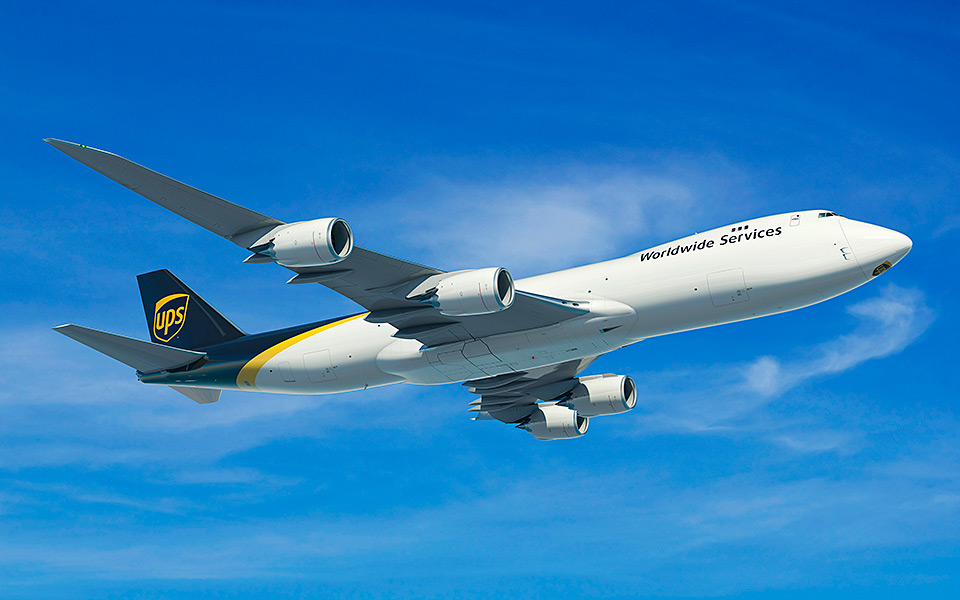Leeham News and Analysis
There's more to real news than a news release.
UPS order tops off 747-8 line through 2020

UPS Boeing 747-8F. Source: Boeing.
Subscription Required
Introduction
Oct. 31, 2016, © Leeham Co.: Last week’s order for 14 Boeing 747-8Fs and 14 options by UPS assures continuation of the program through 2020.
If options are exercised, and if previously announced deals with other customers finally are consummated, the program should continue at least well into the 2020 decade.
Summary
- UPS (but not Boeing) revealed the delivery timeline for the order.
- The mysterious Volga-Dnepr/AirBridgeCargo that was announced at the Paris and Farnborough air shows for up to 20 747-8Fs still hasn’t been firmed up. Only four are listed on the Boeing website this year.
- Iran Air will order four 747-8s under the reported terms of the agreement with Boeing. The US government blessed the deal recently.
- The first of three 747-8s for the presidential fleet is now scheduled for delivery in October 2017, it’s believed.
Pontifications: Hawaiian Air ponders A380
Oct. 31, 2016, © Leeham Co.: Hawaiian Airlines continues to ponder the possibility of acquiring one or two Airbus A380s, its CEO said on the third quarter earnings call—something that raises eyebrows and a lot of questions with industry officials.
Mark Dunkerley, responding to a question on the call, said there are two or three routes that could support the giant A380.
The evolving European legacy carrier
By Bjorn Fehrm
October 13, 2016, ©. Leeham Co, Nice: Scandinavian Airlines (SAS) has fought its way back from a near-death experience in 2012, readjusting to the growing low cost carrier environment in Europe.
After nearly being bought by Lufthansa in 2008 the airline has had to slug it out themselves, gradually fighting its way back to sustained profitability.
Things are now looking up and the development and future of SAS is a good example of the problematic past and future of European legacy carriers.
ISTAT 2016: Air transport market at cross-roads
By Bjorn Fehrm
September 29, 2016, ©. Leeham Co: We visited ISTAT (International Society of Transport Aircraft Trading) 2016 conference in Barcelona this week. The most interesting part of the conference was the economists panel with discussions between the economist: Brian Pierce, chief economist of IATA; Peter Morris, chief economist at Ascend; and Adam Pilarski, SVP and Head of Consulting, AVITAS.
The economists agreed that the air transport market is at a cross-roads, but not which route it will take.
Let’s start with the market facts presented by IATA’s Pierce: Read more
No sanctions will be levied on Airbus and Boeing in WTO dispute
Subscription Required
Now open to all readers.
Introduction
Sept. 26, 2016, © Leeham Co.: It’s hazardous to use the word “never,” but the US and European Union will never impose trade sanctions or tariffs on Airbus or Boeing airplanes.
No sane president would do so. (Cue Donald Trump.) It would start a devastating trade war and the collateral damage on innocents in the Airbus-Boeing illegal subsidies disputes would be severely harmed.
Summary
- US tariffs on Airbus aircraft and EU tariffs on Boeing aircraft would hurt engine makers, suppliers—innocents in the illegal subsidy disputes.
- Some key customers order from Airbus and Boeing. Tariffs on one or the other company risk alienating these customers.
- Sanctions/tariffs permitted on other companies, industries.
- Canada, Brazil never imposed sanctions in Bombard-Embraer violations.
The MAX’s first mission: Cross the Atlantic
By Bjorn Fehrm
14 September 2016, ©. Leeham Co: During 2014, we wrote several articles on what could be a good replacement for the Boeing 757-200Ws operated on trans-Atlantic missions. One of the aircraft we looked at was Boeing’s 737 MAX line.
We found that the most promising variant was the 737 MAX 8. It has a standard range without extra tanks of 3,600nm. Its practical maximum network range would be critically dependent on the cabin configuration. The best configuration would be with a light cabin such as that an LCC would use for transatlantic service—that is, not including heavy, lie-flat seats, but rather seats that might be configured with extra legroom and perhaps greater reclining ability. At the time, we looked at Norwegian Air Shuttle (NAS) as an example.
Flight International now reports in their 13-19 September print magazine that Norwegian might be the first taker of the 737 MAX and that the missions would be trans-Atlantic.
The MAX 8 program is running ahead of schedule. Planned Entry Into Service (EIS) was summer 2017 with Southwest Airlines. Southwest still plans to take delivery of their first 737 MAX 8 at that time with operational service starting in September.
But Boeing is ready to deliver 737 MAX 8s as early as March 2017. The customer for these aircraft would be Norwegian and the planned use should be flights between Europe and US East coast. This means the first mission for the “short haul” 737 MAX should be to cross the Atlantic. Read more







